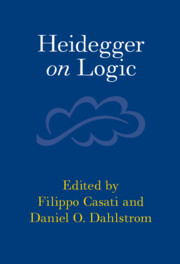Book contents
- Heidegger on Logic
- Heidegger on Logic
- Copyright page
- Contents
- Contributors
- Acknowledgments
- Method of Citation
- Introduction
- Part I Normativity, the Phenomenology of Assertions, and Productive Logic
- Part II Language, Logic, and Nonsense
- Chapter 4 Logic, Language, and the Question of Method in Heidegger
- Chapter 5 Nonsense at Work
- Chapter 6 Heidegger’s “Destruction” of Traditional Logic
- Part III Paradox, the Prospects for Ontology, and Beyond
- Part IV Logical Principles and the Question of Being
- References
- Index
Chapter 5 - Nonsense at Work
Heidegger, the Logical, and the Ontological
from Part II - Language, Logic, and Nonsense
Published online by Cambridge University Press: 15 September 2022
- Heidegger on Logic
- Heidegger on Logic
- Copyright page
- Contents
- Contributors
- Acknowledgments
- Method of Citation
- Introduction
- Part I Normativity, the Phenomenology of Assertions, and Productive Logic
- Part II Language, Logic, and Nonsense
- Chapter 4 Logic, Language, and the Question of Method in Heidegger
- Chapter 5 Nonsense at Work
- Chapter 6 Heidegger’s “Destruction” of Traditional Logic
- Part III Paradox, the Prospects for Ontology, and Beyond
- Part IV Logical Principles and the Question of Being
- References
- Index
Summary
This chapter examines Heidegger’s use of seemingly nonsensical sentences in his 1926 Logic lectures to illustrate the primacy of a kind of practical sense, which serves as a basis for a derivative logical-propositional sense. It contrasts Heidegger’s approach with a conception of nonsense emerging out of an “austere” reading of Wittgenstein’s Tractatus, according to which nonsense is never a function of what words mean but only a result of a failure to assign a meaning to one or more elements of a would-be proposition; according to this austere reading, there are thus no nonsensical propositions, but only strings of meaningless signs. Although Heidegger in certain respects hews to this austere conception, viz. in recognizing the interplay between bipolarity and something’s being a proposition at all, his use of nonsense nonetheless departs from the specifics of the austere reading. Doing so, the chapter argues, allows Heidegger to do a kind of phenomenological-ontological work, whose possibility the austere reading renders obscure (at best).
Keywords
- Type
- Chapter
- Information
- Heidegger on Logic , pp. 90 - 110Publisher: Cambridge University PressPrint publication year: 2022
- 1
- Cited by



